RetroLisa
------------------ |
1910s Travel
part 2
| |
|
___________________________________________________________________________________________________________
|
|
|
RetroLisa
| ________________________________________________ | ___ | ______________________________________________ | ________ | Destinations
visiting friends & relatives
By far, the most popular type of vacation was a trip to visit friends and relatives in other cities. Single ladies spent time with their married sisters, children visited their grandparents, and elderly couples spent winters with their grown children. The local newspaper devoted several columns each week to the topic of who was visiting who. For city families, spending a few weeks on grandpa's farm was a special treat.
It was quite common for young people to spend the summer with cousins and college chums in other cities. At a time when few people ventured beyond the boundaries of their home towns, this practice provided a rare opportunity for young adults to meet new people. Quite a few romances blossomed between house guests and town residents.

Atlantic City, 1914
by the sea
Asbury Park, Atlantic City, and Coney Island were famous for their beaches and boardwalks. Visitors took advantage of the invigorating waves and healthy sea air, enjoyed the concessions and amusements, and filled up on cotton candy and salt water taffy. At many beaches, bathers held onto ropes that extended into the surf. Public bathhouses featured shower rooms, dressing rooms, and bathing suits for rent.
down south
Florida's tourism industry was born in the 1880s when the first railroads reached the state. This brought the wealthy elite, who built elaborate vacation homes along the coast. Miami became a tourist mecca in 1896 when Henry Flagler's railroad was extended south to the city.
Across the bay, the island of Miami Beach was being transformed from a mosquito-infested swamp into a pleasant tourist area. The first bathing pavilion and ferry dock were built there in the 1900s, and the first residential neighborhoods were built in the 1910s. A wooden bridge linking the island to the mainland was also added in the 1910s.
In 1915, the opening of the Dixie Highway brought automobile tourists to Florida. The state soon became a popular destination for anyone with a car and a sense of adventure.
Atlantic City
Atlantic City History Links
The Dixie Highway
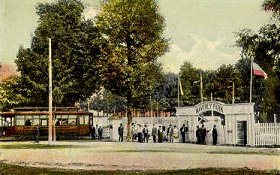
A trolley brings visitors to Waverly Park
trolley parks
In the 1890s, electric companies charged trolley lines a flat rate for electric service. During the week, when ridership was high, trolley companies got their money's worth. On the weekends, however, empty trolleys meant lost profits.
In order to stimulate weekend ridership, trolley companies constructed parks along their routes. Some were simple, with picnic grounds and ponds for pleasure boats. Others were quite elaborate, with rides, concessions, beer gardens, hotels, and live entertainment.
Kennywood (Pittsburgh) and Idora Park (Oakland) were two of the more successful trolley parks. In the late 1910s, there were approximately 1,000 trolley parks across the country.
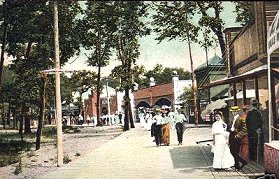
Cedar Point midway, 1910

1911 Dreamland fire
| |
day outings
It was always fun to take a day trip to a nearby beach, picnic grove, or historic site. Travelers packed picnic lunches, grabbed their Kodak Brownie cameras, and hopped aboard the nearest electric car. If they were lucky, they could motor to their destination in an automobile.
expositions
Each international exposition gave its host city a chance to shine.
• 1915 Panama Pacific International Exposition: Also known as the San Francisco World's Fair, this event was designed to celebrate both the completion of the Panama Canal in 1914 and the 400th anniversary of Balboa's discovery of the Pacific Ocean. San Francisco was devastated by an earthquake in 1906, and the fact that she was able to host such a beautiful fair less than ten years later was truly remarkable.
• 1915-1916 Panama California Exposition: This San Diego fair also celebrated the opening of the Panama Canal.
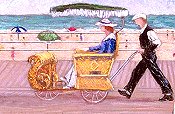
Tired feet? Let an attendant push you in one of Atlantic City's famous wicker rolling chairs.
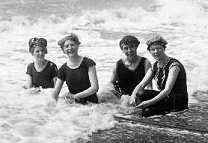
Ocean bathing
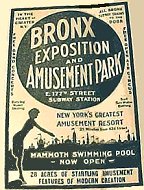
popular amusement parks
east
• Ocean View Park
• Brandywine Springs
• Lake Compounce
• Palisades Amusement Park
• Rockaways' Playland
• Kennywood
midwest
• Riverview Park
• Chippewa Lake Park
• Cedar Point
• White City
• Euclid Beach Amusement Park
• Forest Park Highlands
west
• Idora Park
• Santa Monica Pier
• Fraser Pier
• Kinney Pier
• Wonderland Park
• Santa Cruz Beach Boardwalk
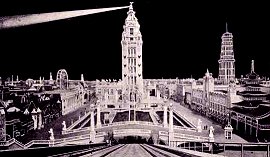
Dreamland
Coney Island
When the decade began, there were three big parks at Coney Island: Dreamland, Luna Park, and Steeplechase Park. There was something here for everyone. Dreamland was the beautiful, gleaming white park that appealed to the upper classes. Steeplechase Park had popular rides and attractions that were enjoyed by the average visitor. Luna Park combined the best of both worlds.
In 1911, Dreamland was destroyed by fire and was not rebuilt. The owners didn't waste a second....the Dreamland Circus Sideshow was built on the site while the embers were still smoldering.
|
_________________________________________________
|
|
|
RetroLisa
| ________________________________________________ | ___ | ______________________________________________ | ________ | Resorts & Campgrounds
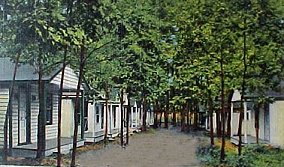
campgrounds
In the 1910s, it was very common for religious organizations and membership clubs to purchase land in the country for meetings and outings. Cottages, tents, dining halls, and auditoriums were erected on the property for use by members and visitors.
In rural areas, church camps and Chautauqua parks hosted yearly assemblies that were famous for miles around. Guests rented cottages and tents and attended sermons, seminars, revivals, and cultural presentations. For many attendees, this was the closest thing they had to a real vacation. The camps were so popular that people visited them all throughout the summer.
While church camps provided spiritual rejuvenation, other camps focused on healthy outdoor fun. Depending on the type of camp you attended, activities like swimming, boating, nature study, and baseball could be highly organized or done at leisure. The scouting and fresh air movements that were popular during this decade provided many kids with organized summer camp experiences.
Most importantly, campgrounds gave people a chance to gather socially in a relaxed outdoor setting.
summer homes & cottages
For city families, spending the summer in the country was a time-honored tradition going back to the early 1800s. Any lakeside town with rail access to the city could see its population double during the summer.
Small towns and rural areas were full of cottages and cabins that families could rent for a week, a month, or the entire season. Families who rented the same cottage year after year became an integral part of the community. Upper-class families rented larger homes or owned their own summer homes.
Mom and the kids (and perhaps a servant or two) stayed all summer, while dad remained in the city and came out on the weekends. Because of this, most resort areas were only a short train ride away from home.
| |
resorts
Spending your vacation at a resort was a popular option. Many places fell into this category. A summer resort might be a hotel, a collection of smaller cabins, a farmer who made extra money by taking in summer boarders, or a privately-owned grove along the river ideal for camping.
Some resort hotels were massive, with accommodations for hundreds of guests. Others were no bigger than a large house. In the kitchen, meals were often prepared using chicken and vegetables raised on the resort property.
An employee from the local resort met guests at the train station and drove them out to the hotel in a carriage or auto. Resorts that were located on rivers often transported their guests by boat.
Fun was found at the local level. During the day, guests enjoyed swimming, boating, fishing, picnics, and going for drives. Many resorts had their own taverns, bowling alleys, and dance pavilions for evening recreation. For an added treat, visitors might go into town to have some ice cream, see a movie, listen to a band concert, or attend a dance.
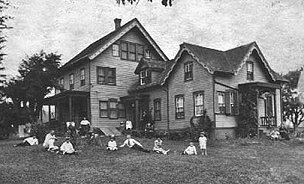
Summer resort
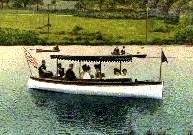
|
_________________________________________________
|
|
|
RetroLisa
| _______________________________________________________________ | __ | _________________________________ | _______ | Travel Lodgings
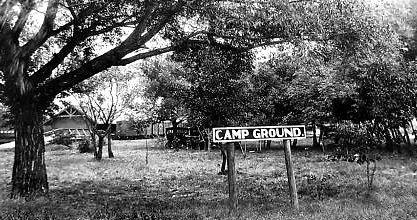
auto camping
In the old days, a typical summer vacation was spent at a cottage or resort chosen in advance. We packed our trunks and boarded the train for a few months of fun at the lake or seashore.
As automobiles became more common, the nature of pleasure travel began to change. For auto owners, the trip itself became an integral part of the vacation experience. When night came, auto travelers became auto campers who slept in their cars or pitched their tents in fields alongside the road.
In the late 1910s, some towns began to establish free auto camps on public land to discourage travelers from parking on private property. Occasionally, you could find an enterprising farmer who allowed motorists to park on his land for a small fee.

LOCAL COUPLE MOTORS TO FLORIDA
In 1915, an adventurous Illinois couple took an automobile trip to Florida. Their packing list included:
* 1 waterproof tent large enough to cover the car with room on the side
* 1 folding cot to place beneath the tent
* 1 folding cot to rest on the back of the car seats
* 1 folding kerosene stove
* 2 folding chairs
* 1 folding table
* 1 folding armchair
* rugs
* dishes, silverware, cooking utensils
* 2 low storage boxes attached to running boards
* clothes in suitcases under rear seat
hotels
Luxurious city hotels had fancy lobbies, private bathrooms, and telephones. For evening recreation, guests enjoyed ballrooms, fine dining, and a bar where the men could gather for cigars and brandy.
Many smaller hotels had sample rooms, where traveling salesmen could display their wares. Sample rooms were also used by traveling doctors and dentists to set up temporary offices.
In New York, the Knickerbocker Hotel boasted murals by Maxfield Parrish, one of the most popular artists of the era. In 1913, New York's Hotel McAlpin was the tallest hotel in the world.
The Beverly Hills Hotel opened in 1912, before the town of Beverly Hills even existed. The area grew very quickly when former hotel guests decided to build homes there. The new suburb was incorporated in 1914.
| |
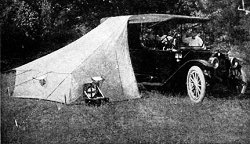
Auto camping, 1915
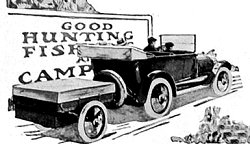
The manufacture and sale of camping equipment became very profitable. Auto tourists could buy tents, cots, chairs, and camp stoves, plus a small trailer to carry it all.
Coast To Coast In 1916
Auto Camping
"Motorists come in a hurry, eat and hurry along...."
--a summer resort owner, complaining about how the motor car was hurting his trade, 1913

Generally, women did not sign hotel registers, as they were not considered suitable reading for the gentler sex. Clerks signed for women traveling alone.
|
_________________________________________________
|
|
|
